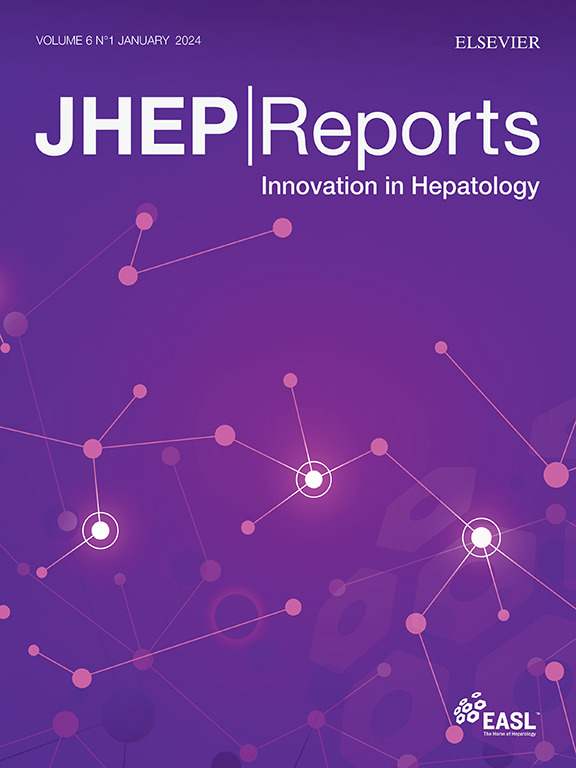CRISPR/Cas9基因治疗增加遗传性酪氨酸血症1型小鼠模型的肿瘤发生风险
IF 9.5
1区 医学
Q1 GASTROENTEROLOGY & HEPATOLOGY
引用次数: 0
摘要
背景,CRISPR基因编辑的治疗潜力已经在各种动物模型中得到证实;然而,人们对其长期后果知之甚少。本研究试图通过在遗传性酪氨酸血症I型(HT-I)动物模型中研究CRISPR基因治疗的持久后果来弥合这一差距。我们比较了nitisinone(一种羟苯基丙酮酸双加氧酶(HPD)的小分子抑制剂)与CRISPR基因治疗HPD基因缺失的治疗标准。这两种处理都阻断了酪氨酸分解代谢的通量,从而防止了HT-I中有毒分解代谢物的积累。方法在nitisinone或CRISPR缺失Hpd治疗12个月后,对富马酰乙酸水解酶缺陷(Fah-/-)小鼠(HT-I型小鼠模型)进行CRISPR基因编辑的疗效和安全性评估。我们使用含有Cas9的腺病毒和含有两个sgRNA的腺相关病毒来删除Hpd基因。主要终点是生存、尿液生化、肝脏(免疫)组织化学和遗传分析。结果scrispr缺失和HPD的药理抑制均显示出有效的代谢纠正和挽救致死性。令人惊讶的是,与四个对照组(nitisinone[19%, 21只小鼠中的4只],仅sgRNA[6%, 16只小鼠中的1只],仅Cas9[11%, 19只小鼠中的2只],以及水动力尾静脉注射两种CRISPR构建体[24%,17只小鼠中的4只])相比,我们发现CRISPR基因治疗组的肝细胞癌发病率显著增加(71%,12/17只小鼠)。在CRISPR基因治疗组中,所有分析的肿瘤都因Hpd而被删除,但显示出开启和关闭的目标载体整合。结论scrispr基因治疗可增加HT-I型小鼠肝癌的发生风险。由于HT-I具有固有的癌症易感性,这一严重的不良事件暴露了CRISPR基因治疗易发癌症疾病的潜在局限性。影响和影响关于体细胞基因编辑的长期后果我们所知不多。本研究利用病毒载体研究CRISPR基因治疗I型酪氨酸血症。尽管基于crispr的治疗有效地治疗了代谢状况,但与目前的标准治疗相比,它与肝癌的发病率更高相关。这些发现强调了在易患癌症的情况下使用CRISPR基因治疗的潜在风险。本文章由计算机程序翻译,如有差异,请以英文原文为准。

CRISPR/Cas9 gene therapy increases the risk of tumorigenesis in the mouse model of hereditary tyrosinemia type I
Background & Aims
The therapeutic potential of CRISPR gene editing has been demonstrated in various animal models; however, little is known about its long-term consequences. This study seeks to bridge this gap by investigating the lasting consequences of CRISPR gene therapy in an animal model of hereditary tyrosinemia type I (HT-I). We compared the standard of care—nitisinone, a small molecule inhibitor of hydroxyphenylpyruvate dioxygenase (HPD)—with the deletion of the Hpd gene by CRISPR gene therapy. Both treatments block flux through tyrosine catabolism and thereby prevent the accumulation of toxic catabolites in HT-I.
Methods
We assessed the efficacy and safety of CRISPR gene editing in fumarylacetoacetate hydrolase-deficient (Fah-/-) mice, the mouse model of HT-I, 12 months post treatment with either nitisinone or CRISPR deletion of Hpd. We deleted the Hpd gene using an adenovirus containing Cas9 and an adeno-associated virus containing two sgRNA against the Hpd gene. Primary endpoints were survival, urine biochemistry, liver (immuno)histochemistry, and genetic analyses.
Results
CRISPR deletion and pharmacological inhibition of HPD both demonstrate efficient metabolic correction and rescue of lethality. Surprisingly, we detected a markedly increased incidence of hepatocellular cancer in the CRISPR gene therapy group (71%, 12/17 mice) compared with four control groups (nitisinone [19%, four of 21 mice], sgRNA only [6%, one of 16 mice], Cas9 only [11%, two of 19 mice], and hydrodynamic tail vein injection of both CRISPR constructs [24%, four of 17 mice]). All analyzed tumors in the CRISPR gene therapy group were deleted for Hpd but showed on-and-off target vector integrations.
Conclusions
CRISPR gene therapy increases the risk of hepatocellular cancer in the mouse model of HT-I. Because HT-I is characterized by inherent cancer susceptibility, this severe adverse event exposes the potential limitations of CRISPR gene therapy in cancer-prone disorders.
Impact and implications
Not much is known about the long-term consequences of somatic gene editing. Our study investigates CRISPR gene therapy in tyrosinemia type I using viral vectors. Although the CRISPR-based therapy effectively treated the metabolic condition, it was associated with a higher incidence of liver cancer than the current standard of care. These findings highlight the potential risks of using CRISPR gene therapy in conditions predisposed to cancer development.
求助全文
通过发布文献求助,成功后即可免费获取论文全文。
去求助
来源期刊

JHEP Reports
GASTROENTEROLOGY & HEPATOLOGY-
CiteScore
12.40
自引率
2.40%
发文量
161
审稿时长
36 days
期刊介绍:
JHEP Reports is an open access journal that is affiliated with the European Association for the Study of the Liver (EASL). It serves as a companion journal to the highly respected Journal of Hepatology.
The primary objective of JHEP Reports is to publish original papers and reviews that contribute to the advancement of knowledge in the field of liver diseases. The journal covers a wide range of topics, including basic, translational, and clinical research. It also focuses on global issues in hepatology, with particular emphasis on areas such as clinical trials, novel diagnostics, precision medicine and therapeutics, cancer research, cellular and molecular studies, artificial intelligence, microbiome research, epidemiology, and cutting-edge technologies.
In summary, JHEP Reports is dedicated to promoting scientific discoveries and innovations in liver diseases through the publication of high-quality research papers and reviews covering various aspects of hepatology.
 求助内容:
求助内容: 应助结果提醒方式:
应助结果提醒方式:


